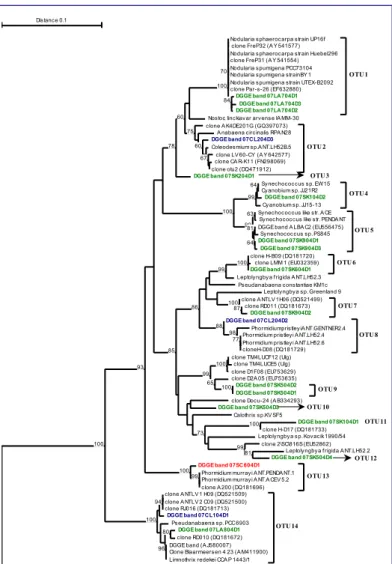Cyanobacterial molecular diversity and
distribution in microbial mats
from antarctic lakes
l
P. De Carvalho Maalouf, A. Lambion, F. Zakhia
and *A. Wilmotte
Center for Protein Engineering, B6, University of Liège, 4000, Liège, Belgium
1. Introduction
Antarctica is a vast continent submitted to
extreme conditions
. The few coastal
deglaciated areas contain lakes that offer
milder conditions where microbial mats can
develop. The latter are dominated by
cyanobacteria. In the frame of the AMBIO
project (
www.ambio.ulg.ac.be
), we aim to
assess the influence of ecological and
historical factors on the distribution of
cyanobacteria in antarctic aquatic habitats.
3. Results
The sequences grouped into 14 OTUs. Seven are
potentially endemic to the Antarctic (OTUs 3, 6, 9,
10, 11, 12 and 13
.
The others have a cosmopolitan
distribution. Each lake from SK and LA have a
different OTU composition (Fig. 2).
4. Conclusion and perspectives
These preliminary results show the existence of
potential endemic cyanobacterial taxa in Antarctica
,
corroborating previous studies (7). They also
indicate that lakes separated by small distances can
have different microbial communities highlighting the
importance of the ecological factors in shaping the
microbial community
.
The integration of the results of the 80 samples that
are now being analyzed will allow us to
assess the
influence of the (more or less) extreme conditions on
the geographic distribution of cyanobacteria along the
3 biogeographic regions of Antarctica.
References : (1) Smalla et al (1993) Jour. Appl. Bact. 74: 78-85. (2) Nadeau et al (2001) Jour. Phycol. 37: 650-654. (3) Boutte et al (2006) Jour. Micr. Meth. 65: 542-550. (4) Drummond et al (2006)
GENEIOUS v2.5. (5) Van de Peer & De Wachter (1997) Comp. Appl. Biosc. 13: 227-230. (6) Schloss et al (2005) Appl. Env. Microb. 71: 1501-1506. (7) Taton et al (2006a FEMS Microb. Ecol. 57:
272-289.
2. Methods
13 samples from 10 lakes from Skavsnes (
SK
), Langhovde (
LA
), Schirmacher
Oasis (
SC
) and Pourquoi-Pas Island (Col Lake,
CL
) were analyzed (Fig. 1). SK,
LA and SC were sampled during the MERLIN campaign in 2007 and CL was
sampled in 2003 during the Sledge Bravo campaign.
DNA was isolated following a modified protocol of Smalla
et al
(1). A semi-nested
PCR was performed (2) and the obtained amplicons were screened by DGGE (3).
Our sequences and their closest relatives (RDP II,
http://rdp.cme.msu.edu/
) were
alligned using GENEIOUS (4) and a distance tree was constructed using
TREECON (5 ; Fig. 2). Finally, sequences sharing more than 97.5% of similarity
were grouped into Operational Taxonomic Units (OTUs) using PHYLIP and
DOTUR (6).
Fig. 1 - Map of Antarctica showing the sampled regions.
Distance 0.1
E colik12
DGGE band 07SK204D1 Nostoc linckiavar arvense IA MM-30
Calothrix sp.KV SF5 clone A K4DE201G (GQ397073)
Pseudanabaena sp. PCC 6903 A nabaena circinalis RPA N28
DGGE band 07CL204D2 Pseudanabaena constantiae KM1c DGGE band 07CL204D3 DGGE band 07SC604D1 PhormidiumpristleyiA NT.GENTNER2.4 Cyanobium sp. JJ15-13 Leptolyngbya f rigida A NT.LH52.3 Leptolyngbya sp. Greenland 9 Leptolyngbya sp. Kovacik 1990/54 Coleodesmium sp.A NT.LH52B.5 DGGE band 07CL104D1 clone 2\SC\816S (EU52862) Phormidium pristleyi A NT.LH52.4 DGGE band 07SK104D2 DGGE band 07SK604D1 clone A NTLV 1H06 (DQ521499) DGGE band (A J580007) clone RJ016 (DQ181713) clone D1F08 (EU753629) clone D2A 05 (EU753635) clone LV 60-CY (A Y 642577)
DGGE band 07LA704D1
Phormidium murrayi A NT.PENDA NT.1 Nodularia sphaerocarpa strain UP16f clone FreP32 (A Y 541577) Nodularia sphaerocarpa strain Huebel296 clone FreP31 (A Y 541554) Nodularia spumigena PCC73104 Nodularia spumigena strainBY 1 Nodularia spumigena strain UTEX-B2092 clone Par-s-26 (EF632880)
DGGE band 07LA704D3 DGGE band 07LA704D2
clone CA R-K11 (FN298069) clone otu2 (DQ471912)
Synechococcus sp. EW15 Cyanobium sp. JJ21R2
Synechococcus like str. A CE Synechococcus like str. PENDA NT DGGE band A LBA C2 (EU556475)
Synechococcus sp. PS845 DGGE band 07SK904D1 DGGE band 07SK904D3 clone H-B09 (DQ181720) clone LMM 1 (EU032359) clone RD011 (DQ181673) DGGE band 07SK904D2 Phormidium pristleyi A NT.LH52.6 cloneH-D08 (DQ181729) clone TM4LUCF12 (Ulg)
clone TM4LUCE5 (Ulg)
DGGE band 07SK504D2 DGGE band 07SK504D1 clone Docu-24 (A B334293) DGGE band 07SK504D3 DGGE band 07SK104D1 clone H-D17 (DQ181733) Leptolyngbya f rigida A NT.LH52.2 DGGE band 07SK504D4
Phormidium murrayi A NT.A CEV 5.2 clone A 200 (DQ181696) clone A NTLV 1 H09 (DQ521509) clone A NTLV 2 C09 (DQ521500)
DGGE band 07LA804D1 clone RD010 (DQ181672)
Clone Blaarmeersen 4 23 (A M411900) Limnothrix redekei CCA P 1443/1 100 93 85 78 60 86 100 100 100 70 75 99 73 99 88 60 100 98 99 99 99 77 100 100 96 94 100 65 67 84 99 64 63 81 64 87 100 100 81 80 OTU 2 OTU 8 OTU 9 OTU 10 OTU 1 OTU 3 OTU 4 OTU 5 OTU 6 OTU 7 OTU 11 OTU 12 OTU 13 OTU 14
